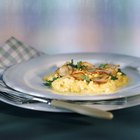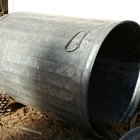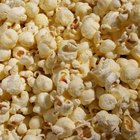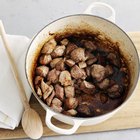
Family camping trips are occasions for roughing it and trying novel ways to complete mundane activities. Cooking your food in empty cans over the campfire is one way to lighten the load of heavy pots and pans to haul to the campsite. It makes good use of the containers you used for the previous meal and can save some KP duties. Observe a few safety precautions before planning your gourmet adventure in can cooking.
Open Flame, Open Can
You may use empty cans for cooking over an open flame but make sure the cans are opened first. The contents of a sealed can cannot expand when heated and that could cause the can to burst. Anything in a sealed can will not leaven so you may end up with an unappetizing mess. Michigan State University Food Domain, a resource for information about food safety, says heating food inside a sealed can could create conditions for botulism to develop -- not what you were planning to serve for dinner.
One-Time Cookware
Use it and lose it. A coffee can is a great camp pot but the folds and crevices in cans make them tough to clean. Use your cans once and then recycle them. Remove all paper labels completely and scrub away any remaining glue before putting a can over a flame. Grease the inside really well so food won't stick in any seams. Iowa State University Extension Service says to try cooking a whole dinner in the can -- put an individual ground beef patty in a greased can and toss in a thick slice of tomato and a few tablespoons of canned corn. Cover the can and cook it over the fire about three or four inches above the coals for about 40 minutes. Top off the feast with a few spoonfuls of buttermilk biscuit mix about halfway through the cooking process and, quicker than you can get the kids to wash their hands, your meal-in-a-can is ready to eat.
Baked Potatoes
Rinse the can from the baked beans and use it to cook a char-free potato over your campfire. Small, finicky eaters will appreciate the appealing, normal-looking spuds you serve from a can. The big kids can wrestle with the foil-wrapped potatoes you cook right in the coals. Butter the potato skin all over and shake salt and pepper on it to season before placing it in the can. Cover the can tightly with heavy foil, and set it next to the fire. Do not open the foil to check on progress. The potato must steam in order to cook all the way through so resist peeking. If the side of the can opposite the fire seems too cool, use a padded mitt or tongs to turn the can so it heats evenly. After an hour or so, you should have a savory, perfectly baked potato.
Chemical Leaching
food cans in the U.S. are typically made from steel and beverage cans are made from aluminum. This is an important difference if you are planning to cook in a can over an open flame. Steel cans might release trace amounts of chromium and nickel when heated but aluminum leaches much more easily, according to Scientific American Magazine. Aluminum is linked to significant health problems, including disorders of the nervous system. The linings that coat most cans of either type may contain BPA, a chemical linked to cancer and reproductive diseases. It might not be a good practice to cook over campfires in cans routinely, unless you limit the use of aluminum and can determine what linings a manufacturer uses. Stick a skillet in your backpack if you are concerned about chemical contamination from cans.
Related Articles

How to Recycle Shaving Cream Cans

Are Nickel Lined Pans Safe?

How to Cook With a Gas Fireplace

The Best Types of Pans to Cook ...

How to Cook in a Galvanized Trash Can

Anodized Vs. Teflon in Cookware

How to Recycle Popcorn Tins

Are Teflon-Coated Pans Oven-Safe?

How to Substitute a Coffee Can for a ...
Can You Cook Pizza Directly on Fire ...

How to Relight BBQ Charcoal

How to Cook Corn on the Fire

Ways to Cook Baked Potatoes Without Foil

Purpose of Moth Balls

What Are the Dangers of Cooking With ...

What Is Better for Cookware: Glass, ...
How to Keep Waffles Hot at a Brunch

How to Put Together a Cuisinart Blender

What Are the Dangers of Titanium in ...

Can Ceramic Cookware Be Used on ...
References
Writer Bio
Benna Crawford has been a journalist and New York-based writer since 1997. Her work has appeared in USA Today, the San Francisco Chronicle, The New York Times, and in professional journals and trade publications. Crawford has a degree in theater, is a certified Prana Yoga instructor, and writes about fitness, performing and decorative arts, culture, sports, business and education .
Photo Credits
Comstock/Comstock/Getty Images